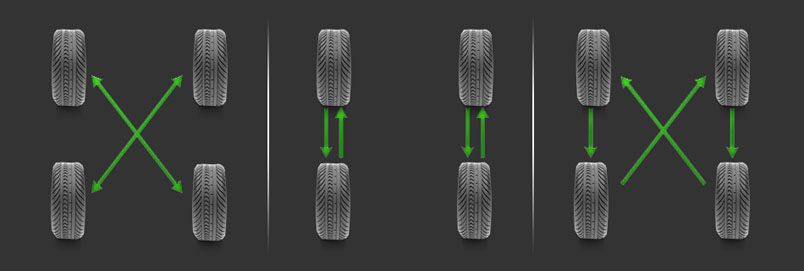Tyre maintenance
CHECK YOUR TIRE INFLATION
Proper tire inflation is essential for safe driving and long tire life. It’s wise to check your tires’ air pressure at least once a month with an accurate tire pressure gauge. Be sure to check pressure while your tires are cold and have not been used recently. Even driving a mile will cause your tire pressure to increase and give you an inaccurate reading.
A continuous loss of inflation pressure may indicate a possible tire or wheel assembly problem. Consult your Toyama retailer immediately if you experience this.
CHECK YOUR TIRE TREAD
Toyama suggests you check your tire tread every 3,000 miles. Here is a simple test:
Check the Tread Wear Indicator Bar: Located at the bottoms of the tread grooves in several locations around the tire. When a tire is so worn that these bars become visibly flush with the adjacent tread ribs, it’s time to replace the tire.
LOADING YOUR VEHICLE
Check your vehicle’s Owner’s Manual to determine the load limits.Maintain axle loads below specified vehicle and tire capacities. Replacement tire load capacity (lbs.) must always meet or exceed original tire “Max Load.” Overloading your vehicle places stress on your tires and other critical vehicle components. Overloading can cause tire failure.
Overloading a vehicle can also cause poor handling and increase fuel consumption. Never fit tires with less load capacity than shown on the vehicle tire placard or original equipmen t tire sidewalls.
KNOW WHAT CERTAIN WEAR PATTERNS MEAN
When wear patterns emerge, they can indicate problems of your tires or your vehicle that would reduce the useful life of a tire. Have your tires checked by Toyama retailer if you notice any of these common wear patterns:
Wear on both edges: UNDERINFLATION
Wear in center: OVERINFLATION
Cups or dips in the tread: WORN PARTS
Sawtooth edges: MISALIGNMENT
MIXING TIRE SIZES AND TYPES
For optimum handling and control, Toyama recommends fitment of tires of the same type and size unless otherwise specified by the vehicle manufacturer. FOLLOW THESE ADDITIONAL GUIDELINES: Fit newest tires on rear axle. If radials and non-radials must be fitted to the same vehicle, fit radials on rear axle. If tires of different profiles must be fitted , fit widest tires on rear axle. Never mix radials and non-radials on the same axle. When fitting snow tires or all-season tires to performance vehicles, always fit in sets. Do not fit tires with differing speed ratings.
Never mix sizes and types on the same axle.
Broadly speaking, tires should not be mixed. It is recommended that all tires on a vehicle should be of similar tread pattern, same performance rating, size and construction, unless the vehicle was engineered for front and rear tires of different sizes.
TIRE ROTATION
Rotating your tires means moving them from one side of the vehicle to the other, moving them from front to back or a combination of both. Regular tire rotation helps avoid uneven tire wear that can lead to poor performance and gas mileage.
Some tires need rotated at specific intervals, while others will need rotated depending on the wear. To find out when your tires need rotated, check your vehicle’s owner’s manual or ask your TOYAMA TYRE retailer.
While many people are knowledgeable enough to rotate their own tires, the procedure is especially quick and easy for a professional. Your vehicle’s owner’s manual will specify the proper rotation pattern and schedule for your vehicle. If no specific schedule is indicated, a good rule of thumb is to rotate your tires every 6,000 to 8,000 miles.
CHECKING FOR DAMAGE
Frequent inspection of your tires for signs of damage and their general condition is important for safety. If you have any questions, have your tire dealer inspect them. Impacts, penetrations, cracks, knots, bulges or air loss always require tire removal and expert inspection. Never perform a temporary repair or use an inner tube as a substitute for a proper repair. Only qualified persons should repair tires.
TIRE BALANCING
If your tires are unbalanced, you’ll notice vibration. This can lead to driver fatigue, premature or irregular tire wear and unnecessary wear to your vehicle’s suspension. Your tires should be balanced when they are mounted on wheels for the first time or when they are remounted after repair. Check your tire balance at the first sign of vibration or shimmy.
VEHICLE ALIGNMENT
Your vehicle is properly aligned when all of its suspension and steering components are working smoothly and when its tire and wheel assemblies are running straight and true. If you notice uneven tread wear, it could be due to a misalignment and your vehicle should be serviced by a professional.



